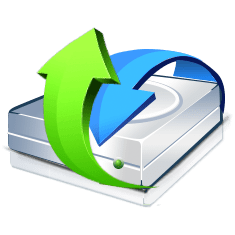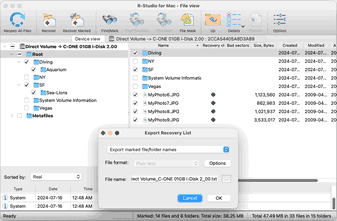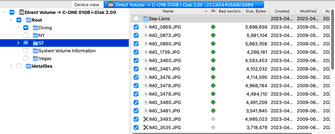


- Contents
- Index
- Introduction to R-Studio for Mac
-
Data Recovery Using R-Studio
- Basic File Recovery
- Advanced Data Recovery
- Mass File Recovery
-
Volume Sets and RAIDs
- Volume Sets, Stripe Sets, and Mirrors
- Basic RAID 4 and RAID 5 Operations
- Working with RAID6 Presets
- Working with RAID6 (Double Xor) Presets
- Working with RAIDs with Parity Delays
- Working with Advanced RAID Layouts
- Nested and Non-Standard RAID Levels
- Finding RAID Parameters
- Checking RAID consistency
- Syntax of a Description File for RAID Configurations
- Description Files for RAID Configurations
- Various Disk and Volume Managers
- Data Recovery over Network
-
R-Studio Technician/T80+
- USB Activation (Technician only)
- Show Files (Advanced)
- Multitasking
- Additional Recovery Options
- Connecting Virtual Objects to the System as Virtual Drives
- Opening Virtual Disks from the Files Panel
- Hidden Devices
- Extended File Information
- Symbolic Link Processing
- Custom Recovery Lists
- Drive Copy Wizard
- File Maps
- I/O Monitor and Sector Map Files
- Runtime Imaging
- Multi-pass Imaging
- Reverse RAIDs
- Working with the Third-Party Hardware
- Forensic Mode
- Text/Hexadecimal Editor
- Technical Information and Troubleshooting
- R-Studio Emergency
- R-Studio Agent Emergency
© 2025 R-Tools Technology Inc.
All rights reserved.
File Recovery Lists
You may create a file containing a list of files and folder found on a disk/ partition . Then such file may be manually edited to specify files to recover and then loaded back into R-Studio . R-Studio will automatically mark the files in this list for recovery. Such file lists recovery are very useful, for example, when it is necessary to have such file lists approved for recovery by someone else who is far away from the computer where R-Studio is running.
You may create file recovery lists for the entire disk or for specific folders. Moreover, you may create a file recovery list for all files within the disk/folder, or for marked files/folders only.
All versions of R‑Studio can create recovery lists in the plain text format with basic functionality. R‑Studio Technician/T80+ can create custom recovery lists in other formats with more advanced options
Creating a simple recovery list
To create a recovery list
| 1 | F or an entire disk, s elect Export Recovery List on the File menu , or |
Right-click the uppermost folder (higher than Root , usually the letter or the name of the disk) and select Export Recovery List on the shortcut menu.
| For a specific folder, right-click the folder and select Export Recovery List on the shortcut menu. |
| 2 | Specify the place to save the recovery list and other necessary options on the Export Recovery List dialog box |
 Export Recovery List options
Export Recovery List options
|
Export the entire folder/file tree Export marked file/folder names Export file/folder names |
Specifies which file and folder names will be exported. |
|
File format: |
A file format for the recovery list. Only text format is available for the standalone and corporate versions. R‑Studio Technician/T80+ can create custom recovery lists in other formats with more advanced options The following formats are available for R‑Studio Technician/T80+ version: Plain Text HTML XML JSON CSV |
|
File name: |
Specifies a file name of the recovery list. |
Editing the file recovery list
All files without any marks in the recovery list will be marked when the list is loaded into R‑Studio . So, if you have some files in the recovery list that don't need to be recovered, just delete them from the list. In addition, you may use the following marks to specify some options
|
:+ |
Mark the file, or the folder, all its files, and subfolders within the folder. |
|
:* |
Mark the file, or the folder and its files, don't mark subfolders in the folder. |
|
:- |
Unmark the file, or the folder, its files, and subfolders in the folder. |
|
:= |
Unmark the file or the folder and its files, dont unmark subfolders in the folder. |
|
:! |
Provide the information on the file. ( R-Studio Technician/T80+ only) |
R‑Studio for Linux processes records in the list consequently. That is, if there are the following lines in the file,
:+Files_to_Recover\
:-Files_to_Delete\File_2.jpg
the file File_2.jpg won't be marked for recovery, while for the lines
:-Files_to_Recover\File_2.jpg
:+Files_to_Recover\
file File_2.jpg will be.
Loading the edited recovery list
To load a recovery list into R‑Studio for Linux,
| * | Select Import Recovery List from the File menu and select the file, or |
Right-click the uppermost folder (higher than Root , usually the letter or the name of the disk) and select Import Recovery List on the shortcut menu.
| > | R‑Studio for Linux will load the file and mark the files accordingly. |
An example of a simple recovery list
As an example, we'll create a simple recovery list, edit it to mark only those files that are to be recovered, and load it back to mark those files.
To create such recovery list
| * | Mark the necessary folders, right-click the Root folder, and select Export Recovery List on the shortcut menu. |
Right-click the uppermost folder (higher than Root , usually the letter or the name of the disk) and select Export Recovery List on the shortcut menu.
Specify the necessary options and click the OK button.
| > | R-Studio will save the file. |
Structure of a simple recovery list file created by R-Studio
:# Version = 1
:# Sort = by real
:# PathDelim = /
:# CaseSensitive
:# Drive = type:"Volume"; size:"1048576000"; label:"ntfs test"; fs:"NTFS";
:# Parent = type:"Drive"; size:"1048576000"; serial:"2cca54405a8d3a89"; firmware:"2.00"; product:"01gb i-disk"; vendor:"c-one";
Diving/
Diving/Aquarium/
Diving/Aquarium/20190822_100644.jpg
Diving/Aquarium/20190822_101620.jpg
Diving/Aquarium/20190822_102526.jpg
Diving/Aquarium/20190822_103830.jpg
Diving/Aquarium/20190822_104333.jpg
Diving/MyPhoto1.jpg
Diving/MyPhoto2.jpg
Diving/MyPhoto3.jpg
Diving/MyPhoto4.JPG
Diving/MyPhoto5.jpg
SF/
SF/Sea-Lions/
SF/Sea-Lions/IMG_3493.JPG
SF/Sea-Lions/IMG_3535.JPG
SF/Sea-Lions/IMG_3542.JPG
SF/Sea-Lions/IMG_3579.JPG
SF/Sea-Lions/IMG_3580.JPG
SF/Sea-Lions/IMG_3581.JPG
SF/Sea-Lions/IMG_3589.JPG
SF/IMG_0869.JPG
SF/IMG_0873.JPG
SF/IMG_0890.JPG
SF/IMG_1739.JPG
SF/IMG_3460.JPG
SF/IMG_3461.JPG
SF/IMG_3476.JPG
SF/IMG_3478.JPG
SF/IMG_3479.JPG
SF/IMG_3480.JPG
SF/IMG_3481.JPG
SF/IMG_3493.JPG
SF/IMG_3535.JPG
SF/IMG_3542.JPG
SF/IMG_3579.JPG
SF/IMG_3580.JPG
SF/IMG_3581.JPG
SF/IMG_3589.JPG
SF/IMG_3590.JPG
SF/IMG_3591.JPG
SF/IMG_3592.JPG
SF/IMG_3593.JPG
SF/IMG_3594.JPG
SF/IMG_3595.JPG
SF/IMG_3596.JPG
SF/IMG_3608.JPG
SF/IMG_3627.JPG
MyPhoto6.JPG
MyPhoto7.JPG
MyPhoto8.JPG
MyPhoto9.JPG
If such recovery list is created from an entire logical disk/partition, it will contain several virtual folders. For example, they'll have the following structure for an NTFS partition.
System Volume Information/
System Volume Information/IndexerVolumeGuid
System Volume Information/WPSettings.dat
Vegas/
MyPhoto6.JPG
MyPhoto7.JPG
MyPhoto8.JPG
MyPhoto9.JPG
///m/$Extend/
///m/$Extend/$Deleted/
///m/$Extend/$RmMetadata/
///m/$Extend/$RmMetadata/$Txf/
///m/$Extend/$RmMetadata/$TxfLog/
///m/$Extend/$RmMetadata/$TxfLog/$Tops
///m/$Extend/$RmMetadata/$TxfLog/$TxfLog.blf
///m/$Extend/$RmMetadata/$TxfLog/$TxfLogContainer00000000000000000001
///m/$Extend/$RmMetadata/$TxfLog/$TxfLogContainer00000000000000000002
///m/$Extend/$RmMetadata/$Repair
///m/$Extend/$ObjId
///m/$Extend/$Quota
///m/$Extend/$Reparse
///m/$AttrDef
///m/$BadClus
///m/$Bitmap
///m/$Boot
///m/$LogFile
///m/$MFT
///m/$MFTMirr
///m/$Secure
///m/$UpCase
///m/$Volume
Now we need to edit this file to mark for recovery the following folders/files:
1. All files in the root folder;
2. Two files MyPhoto1.jpg and MyPhoto3.jpg in the Diving subfolder;
3. All files in the Diving/Aquarium/ folder;
4. All files in the SF/ folder except the SF/Sea-Lions/ subfolder.
The edited simple recovery list
The final simple recovery list will be the following:
:# Version = 1
:# Sort = by real
:# PathDelim = /
:# CaseSensitive
:# Drive = type:"Volume"; size:"1048576000"; label:"ntfs test"; fs:"NTFS";
:# Parent = type:"Drive"; size:"1048576000"; serial:"2cca54405a8d3a89"; firmware:"2.00"; product:"01gb i-disk"; vendor:"c-one";
:= Diving/
:+ Diving/Aquarium/
:+ Diving/MyPhoto1.jpg
:+ Diving/MyPhoto3.jpg
:+ SF/
:- SF/Sea-Lions/
MyPhoto6.JPG
MyPhoto7.JPG
MyPhoto8.JPG
MyPhoto9.JPG
Loading the edited recovery list
When we load this recovery list into R‑Studio for Linux , will see the following results;
- R-Studio Technician: activation using a USB stick
- Data Recovery Guide
- Why R-Studio?
- R-Studio for Forensic and Data Recovery Business
- R-STUDIO Review on TopTenReviews
- File Recovery Specifics for SSD devices
- How to recover data from NVMe devices
- Predicting Success of Common Data Recovery Cases
- Recovery of Overwritten Data
- Emergency File Recovery Using R-Studio Emergency
- RAID Recovery Presentation
- R-Studio: Data recovery from a non-functional computer
- File Recovery from a Computer that Won't Boot
- Clone Disks Before File Recovery
- HD Video Recovery from SD cards
- File Recovery from an Unbootable Mac Computer
- The best way to recover files from a Mac system disk
- Data Recovery from an Encrypted Linux Disk after a System Crash
- Data Recovery from Apple Disk Images (.DMG files)
- File Recovery after Re-installing Windows
- R-Studio: Data Recovery over Network
- How To Use R-Studio Corporate Package
- Data Recovery from a Re-Formatted NTFS Disk
- Data Recovery from an ReFS disk
- Data Recovery from a Re-Formatted exFAT/FAT Disk
- Data Recovery from an Erased HFS Disk
- Data Recovery from an Erased APFS Disk
- Data Recovery from a Re-Formatted Ext2/3/4FS Disk
- Data Recovery from an XFS Disk
- Data Recovery from a Simple NAS
- How to connect virtual RAID and LVM/LDM volumes to the operating system
- Specifics of File Recovery After a Quick Format
- Data Recovery After Partition Manager Crash
- File Recovery vs. File Repair
- Data Recovery from Virtual Machines
- How to Connect Disks to a Computer
- Emergency Data Recovery over Network
- Data Recovery over the Internet
- Creating a Custom Known File Type for R-Studio
- Finding RAID parameters
- Recovering Partitions on a Damaged Disk
- NAT and Firewall Traversal for Remote Data Recovery
- Data Recovery from an External Disk with a Damaged File System
- File Recovery Basics
- Default Parameters of Software Stripe Sets (RAID 0) in Mac OS X
- Data Recovery from Virtual Hard Disk (VHD/VHDX) Files
- Data Recovery from Various File Container Formats and Encrypted Disks
- Automatic RAID Parameter Detection
- IntelligentScan Data Recovery Technology
- Multi-pass imaging in R-Studio
- Runtime Imaging in R-Studio
- Linear Imaging vs Runtime Imaging vs Multi-Pass Imaging
- USB Stabilizer Tech for unstable USB devices
- Joint work of R-Studio and PC-3000 UDMA hardware
- Joint work of R-Studio and HDDSuperClone
- R-Studio T80+ - A Professional Data Recovery and Forensic Solution for Small Business and Individuals Just for 1 USD/day
- Backup Articles
- R-Drive Image Standalone and Corporate license transferring
- Fixing Windows update error 0x80070643 with R-Drive Image
- Backup with Confidence
- R-Drive Image as a free powerful partition manager
- Computer Recovery and System Restore
- Disk Cloning and Mass System Deployment
- Accessing Individual Files or Folders on a Backed Up Disk Image
- R-Drive Image startup / bootable version
- File Backup for Personal Computers and Laptops of Home and Self-Employed Users
- Creating a Data Consistent, Space Efficient Data Backup Plan for a Small Business Server
- How to Move the Already Installed Windows from an Old HDD to a New SSD Device and Create a Hybrid Data Storage System
- How to Move an Installed Windows to a Larger Disk
- How to Move a BitLocker-Encrypted System Disk to a New Storage Device
- How to backup and restore disks on Linux and Mac computers using R-Drive Image
- Undelete Articles
- Get Deleted Files Back
- Free Recovery from SD and Memory cards
- R-Undelete: Video Recovery
- Recovery from an External Device with a Damaged File System
- File recovery from a non-functional computer
- Free File Recovery from an Android Phone Memory Card
- Free Photo and Video File Recovery Tutorial
- Easy file recovery in three steps







